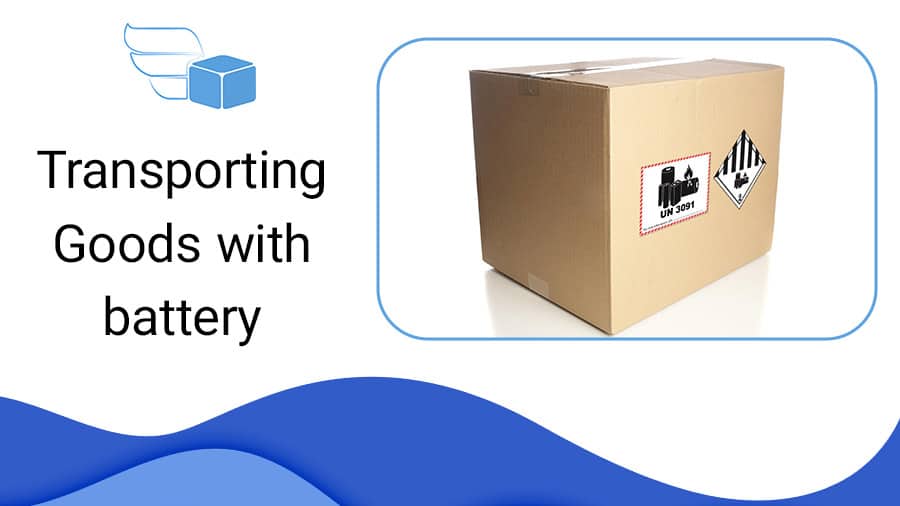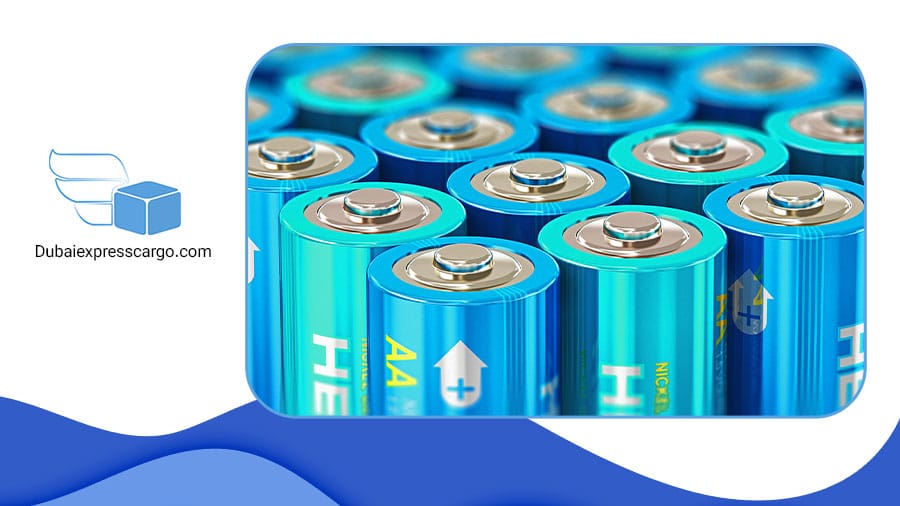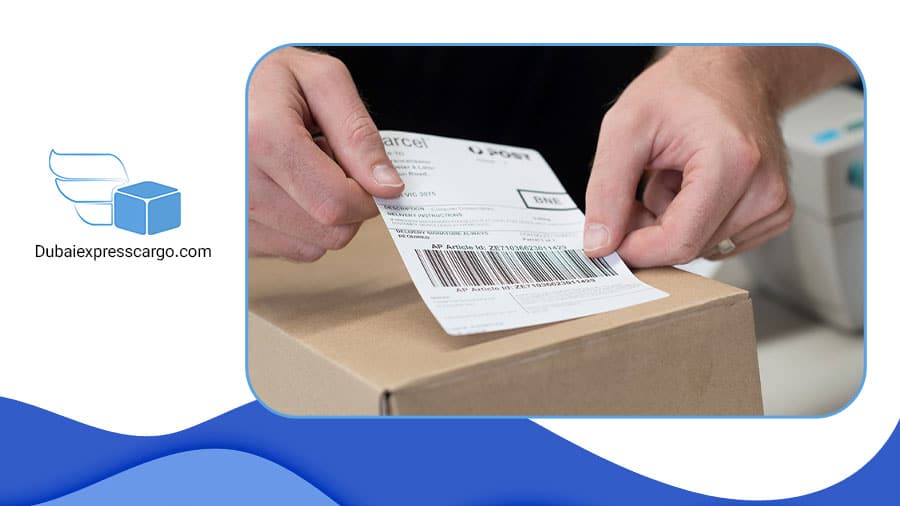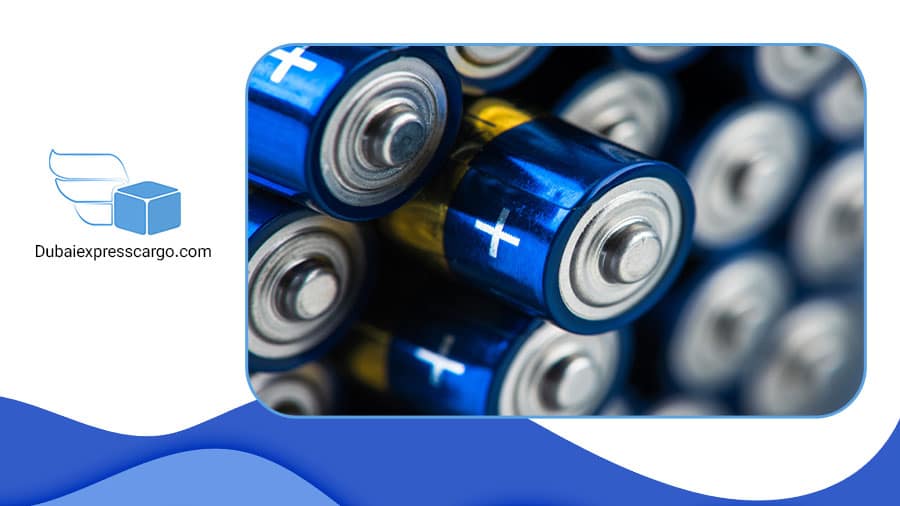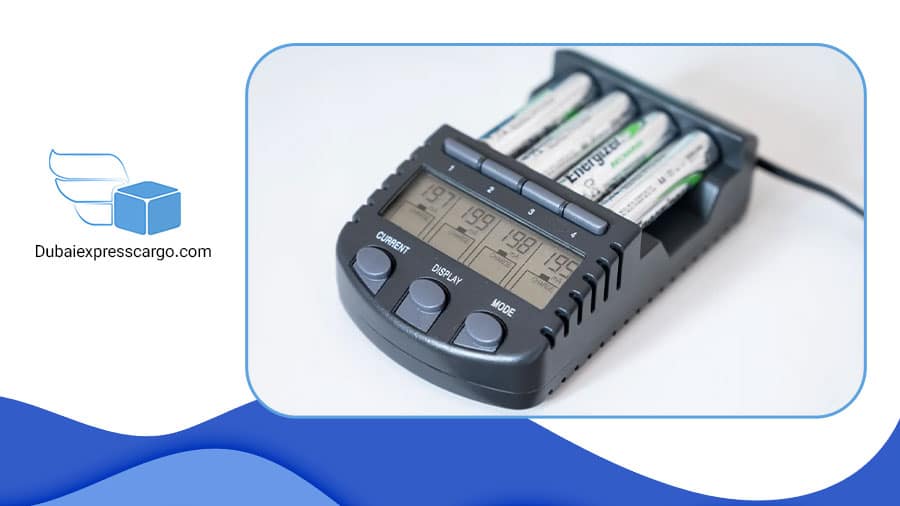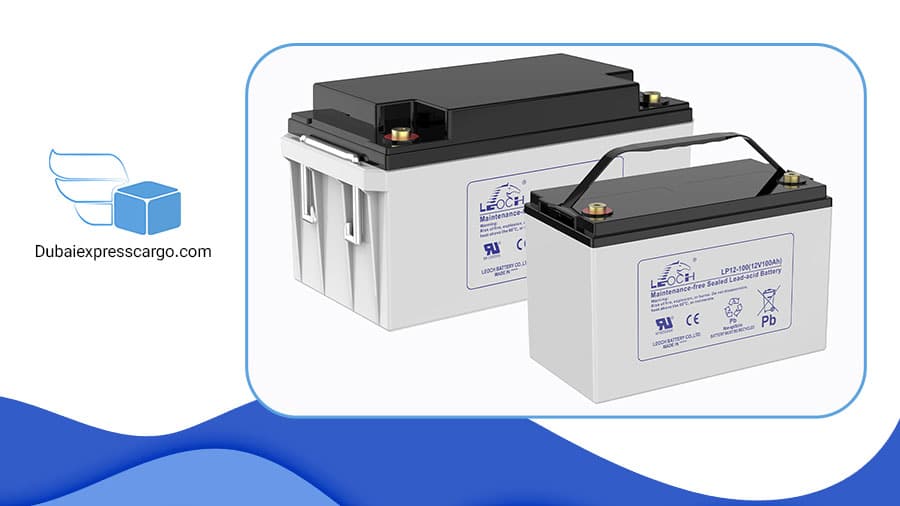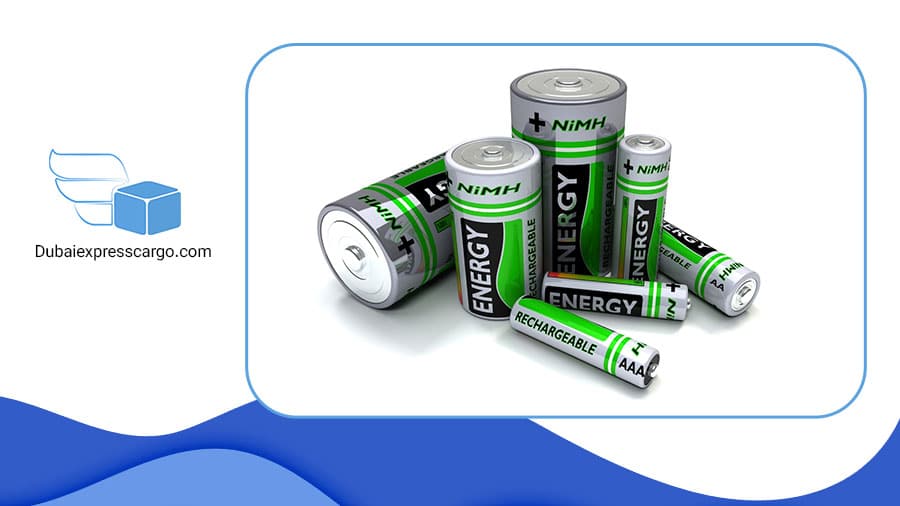Shipping goods with batteries requires careful consideration and adherence to specific safety regulations to ensure these potentially hazardous materials are safe and secure transport.
In the following, Dubai Express Cargo has prepared a comprehensive guide on how to ship goods with batteries.
Contents
1. Identify the Battery Type
1. Identify the Battery Type
The type of batteries you’re shipping is crucial for determining the appropriate packing and labeling requirements.
Batteries are categorized into primary batteries (single-use) and secondary batteries (rechargeable). Secondary batteries, particularly lithium-ion batteries, are considered more hazardous due to their higher energy density and potential for thermal runaway or explosion.
2. Packing and Protection
Proper packing and protection are essential to prevent battery damage and minimize the risk of short circuits or other safety hazards. Follow these guidelines:
- Protect Battery Terminals:
Cover exposed battery terminals with insulating materials like electrical tape or plastic bags to prevent short circuits.
- Use Proper Inner Packaging:
Pack individual batteries in fully enclosed, non-conductive containers to safeguard against short circuits.
- Pad and Secure Packing:
Fill empty spaces within the packaging with soft material like bubble wrap or packing peanuts to prevent movement and reduce the risk of damage.
- Select Strong Outer Packaging:
Choose a sturdy outer packaging, such as a corrugated cardboard box that can withstand handling and transportation without collapsing or tearing.
- Avoid Mixing Battery Types:
Never mix different types of batteries within the same package. This could lead to unwanted reactions or incompatibilities.
3. Labeling and Marking
Clear and prominent labeling is essential for identifying hazardous goods and ensuring proper handling during the shipping process. Follow these guidelines:
- Mark “Hazardous Materials”:
Clearly label the outer packaging with the hazard class and compatibility group (e.g., UN3481, UN3090) to indicate the presence of hazardous materials.
- Affix Lithium Symbol:
Depending on the battery type, attach the UN lithium metal or lithium-ion symbol to the outer packaging.
- Attach Shipping Documents:
Provide the carrier with the required shipping documents, such as the Dangerous Goods Declaration (DGD) and the Shipper’s Declaration for Dangerous Goods (Shipper’s DGD).
4. Compliance with Regulations
Shipping batteries often involves complying with specific regulations and guidelines set by regulatory bodies like the International Air Transport Association (IATA), the United Nations (UN), and the Department of Transportation (DOT).
Research and adhere to the applicable regulations for your specific shipping route and mode of transportation.
5. Consider Professional Shipping Services
For larger or more complex shipments of batteries, consider using the services of a freight forwarder or specialized hazardous materials (HAZMAT) shipper.
These professionals have the expertise and experience to ensure proper packing, labeling, and compliance with regulations, minimizing the risk of incidents and ensuring the safe delivery of your goods.
What are international regulations for shipping goods with batteries?
Shipping goods with batteries are subject to stringent international regulations to ensure these potentially hazardous materials are safely transported securely.
The primary international organizations that set and enforce these regulations are:
1. International Air Transport Association (IATA):
The IATA Dangerous Goods Regulations (DGR) outline the specific requirements for shipping batteries by air.
These regulations cover packaging, labeling, documentation, and state of charge limitations for various types of batteries, including lithium metal and lithium-ion batteries.
2. United Nations (UN):
The UN Recommendations on the Transport of Dangerous Goods (TDG) provide comprehensive guidelines for the international transport of dangerous goods, including batteries. These guidelines cover all modes of transportation, including air, road, sea, and rail.
3. Department of Transportation (DOT):
In the United States, the DOT’s Hazardous Materials Regulations (HMR) govern the transporting of hazardous materials, including batteries. These regulations are aligned with the IATA DGR and UN TDG guidelines.
Different types of battery regulations for shipping
- Restrictions on Passenger Aircraft:
Lithium metal batteries are generally prohibited on passenger aircraft, and lithium-ion batteries are subject to strict limitations.
- Special Provisions:
Some countries may have additional or stricter regulations for shipping batteries within their jurisdiction. It is essential to check and comply with all applicable regulations.
- Expertise and Professional Assistance:
For larger or complex shipments, consulting with a freight forwarder or specialized hazardous materials (HAZMAT) shipper is advisable. They have the expertise and experience to navigate the regulatory requirements and ensure the safe transport of battery shipments.
1. Primary (Single-Use) Batteries
- Lithium Cell Batteries:
- Non-rechargeable: Class 9, UN3090
- Rechargeable: Class 9, UN3481
Packing Requirements:
- Individual cells: Packing Instruction 871
- Batteries in equipment: Packing Instruction 872
Lithium Symbol: Pictogram 9
Dangerous Goods Declaration: Shipper’s Declaration for Dangerous Goods (Shipper’s DGD)
2. Secondary (Rechargeable) Batteries
- Lithium Metal Batteries:
- Generally prohibited for transport by air
- Under certain restrictions for transport by sea and ground
Packing Requirements:
- Lithium metal batteries in equipment: Packing Instruction 968
- Lithium metal batteries packed by themselves: Packing Instruction 967
Lithium Symbol: Pictogram 9
Dangerous Goods Declaration: Shipper’s Declaration for Dangerous Goods (Shipper’s DGD)
Lithium-Ion Batteries:
- Generally permitted for transport by air, sea, and ground
- Subject to state of charge (SoC) limitations for air transport
Packing Requirements:
- Lithium-ion batteries in equipment: Packing Instruction 965
- Lithium-ion batteries packed by themselves: Packing Instruction 968
Lithium Symbol: Pictogram 9
Dangerous Goods Declaration: Shipper’s Declaration for Dangerous Goods (Shipper’s DGD)
3. Lead-Acid Batteries:
- Class 8, UN3480
Packing Requirements:
- Non-spillable batteries: Packing Instruction 873
- Spillable batteries: Packing Instruction 874
Lithium Symbol: Not required
Dangerous Goods Declaration: Shipper’s Declaration for Dangerous Goods (Shipper’s DGD)
4. Nickel-Cadmium and Nickel-Metal Hydride Batteries:
- Class 9, UN3481 and UN3090
Packing Requirements:
- Non-spillable batteries: Packing Instruction 872
- Spillable batteries: Packing Instruction 873
Lithium Symbol: Not required
Dangerous Goods Declaration: Shipper’s Declaration for Dangerous Goods (Shipper’s DGD)
Additional Regulations for Shipping Batteries:
- Shipments of batteries must be labeled with the appropriate hazard class, compatibility group, and lithium symbol.
- Shipments of batteries must be accompanied by Dangerous Goods Declaration (DGD) documents.
- Shipments of batteries must comply with all applicable state and local regulations.
Shipping batteries safely and competently is essential to protect people, property, and the environment.
The role of Dubai Express Cargo as a shipping company for importing goods with battery
Dubai Express Cargo is crucial in facilitating the safe and compliant import of goods with batteries into Dubai and the UAE.
As a specialized cargo company with expertise in handling hazardous materials, they offer a comprehensive suite of services tailored to the specific needs of battery imports.
Key Services Provided by Dubai Express Cargo:
Express Cargo adheres to stringent international regulations for packaging and labeling batteries to ensure their safe transport. They employ experienced staff who understand the handling and protective measures required for various battery types, including lithium-ion and lead-acid batteries.
- Dangerous Goods Documentation:
Dubai Express Cargo assists clients in preparing the necessary Dangerous Goods (DG) documentation, including the Dangerous Goods Declaration (DGD) and Shipper’s Declaration for Dangerous Goods (Shipper’s DGD). These documents provide critical information about the hazardous materials, packaging, and emergency contact details to ensure smooth transportation and compliance with regulations.
- Transportation Expertise:
Dubai Express Cargo has extensive experience in transporting batteries across various modes of transportation, including air, sea, and road. They collaborate with reputable carriers specializing in handling hazardous materials to ensure the safe and timely delivery of battery shipments.
- Customs Clearance:
Dubai Express Cargo handles the complex customs clearance process for battery imports, ensuring that all necessary documentation, certifications, and fees are in order, expediting the release of goods from customs, and minimizing delays.
Value-Added Services:
- Storage Solutions:
Dubai Express Cargo offers secure and temperature-controlled storage facilities for battery shipments, ensuring their safety and integrity during transit or pre-shipment periods.
- Consulting and Guidance:
They provide expert consultation and guidance to clients on the specific regulations and requirements for shipping batteries into Dubai and the UAE, ensuring compliance and minimizing potential risks.
Benefits for Customers:
- Peace of Mind:
Dubai Express Cargo handles the complexities and risks associated with battery imports, allowing customers to focus on their core business operations without worrying about the safe and compliant transportation of their goods.
- Reduced Risks:
Our expertise and adherence to regulations minimize the potential for accidents, incidents, and environmental hazards, ensuring the safe and secure transport of batteries.
- Time Efficiency:
Dubai Express Cargo streamlines the import process, reducing delays and ensuring timely delivery of battery shipments, minimizing disruptions to businesses and operations.
FAQ
1. What are the different types of batteries that require special handling for international importing?
Batteries are categorized into different types based on their chemistry and energy density. Primary (single-use) batteries, such as AA and AAA batteries, typically pose lower risks and may not require specialized handling.
Secondary (rechargeable) batteries, such as lithium-ion and lead-acid batteries, are generally considered hazardous materials and require strict packaging, labeling, and documentation requirements for international importing.
Which international regulatory bodies govern the import of goods with batteries?
The primary international organizations that set and enforce regulations for shipping batteries are the International Air Transport Association (IATA), the United Nations (UN), and the Department of Transportation (DOT).
The IATA’s Dangerous Goods Regulations (DGR) govern air transport, the UN’s Recommendations on the Transport of Dangerous Goods (TDG) cover all modes of transportation, and the DOT’s Hazardous Materials Regulations (HMR) apply to shipments within the United States.
3. What are the specific packaging and labeling requirements for importing goods with batteries?
The packaging and labeling requirements for importing goods with batteries vary depending on the type of battery and the mode of transportation. Generally, batteries must be packed in sturdy, non-conductive containers to prevent damage and short circuits.
Clear and prominent hazard markings must be applied to the outer packaging, including the UN lithium symbol and the appropriate hazard class.
4. What documentation is required for importing goods with batteries?
The specific documentation requirements for importing goods with batteries vary depending on the type of battery, the country of origin, and the country of destination.
Generally, a Dangerous Goods Declaration (DGD) is required, which provides detailed information about the hazardous materials, packaging, and emergency contact details.
Additional documents, such as battery safety data sheets (SDS) or technical documentation, may also be required.
5. What are the restrictions on importing lithium-ion batteries by air?
Lithium-ion batteries are generally permitted for air transport, but there are restrictions on the state of charge (SoC).
The maximum allowable SoC for lithium-ion batteries varies by airline and may be based on the battery type, capacity, and packaging.
Overcharging can increase the risk of thermal runaway or explosion, and the SoC restrictions aim to mitigate this risk.
6. What are the special considerations for importing goods with batteries to specific countries?
Some countries may have additional or stricter regulations for importing batteries. For example, some countries may prohibit importing specific types of batteries or impose additional labeling or documentation requirements. It is crucial to research and comply with all applicable import regulations for the specific country or region of destination.
7. What are the risks associated with improper handling of batteries during international importing?
Improper handling of batteries during international importing can pose significant risks to people, property, and the environment. Batteries can short-circuit, overheat, or explode if not handled and packed properly.
These incidents can cause fires, explosions, injuries, and environmental contamination.
8. What are the benefits of using a freight forwarder or specialized hazardous materials (HAZMAT) shipper for importing goods with batteries?
Freight forwarders and specialized HAZMAT shippers have the expertise, experience, and resources to ensure the safe and compliant importing of goods with batteries.
They can assist with packaging, labeling, documentation, transportation, customs clearance, and other requirements. This can help to reduce risks, minimize delays, and ensure a smooth importing process.
9. What are some tips for choosing a reliable and experienced freight forwarder or specialized HAZMAT shipper for importing goods with batteries?
When choosing a freight forwarder or specialized HAZMAT shipper, consider their experience in handling hazardous materials, their knowledge of applicable regulations, their track record of safety, and their customer service reputation.
Request references and conduct thorough research to ensure you choose a reputable and experienced partner.
10. What additional factors should be considered when importing goods with batteries internationally?
In addition to the specific packaging, labeling, and documentation requirements, it is important to consider the following factors:
- Type of battery: Primary vs. secondary
- Battery capacity: High-capacity batteries may require additional safety measures
- Mode of transportation: Air, sea, or road
- Country of origin and destination: Different regulations may apply
- Customs clearance procedures: Ensure all documentation is in order
- Insurance coverage: Consider additional insurance for hazardous materials
11. What are the procedures for importing goods with batteries by sea?
Shipping goods with batteries by sea requires adherence to the International Maritime Dangerous Goods Code (IMDG Code), which aligns with the IATA DGR and UN TDG guidelines.
Similar to air transport, batteries must be properly packed, labeled, and documented for sea shipments.
12. What are the special considerations for transporting batteries by road?
Transporting batteries by road involves complying with the specific regulations of the country or region where the road journey takes place.
Generally, the same packaging, labeling, and documentation requirements apply to air and sea transport.
13. Why are lithium-ion batteries more regulated than other batteries for international importing?
Lithium-ion batteries pose a higher risk of thermal runaway or explosion due to their higher energy density than primary (single-use) batteries.
This risk necessitates more stringent international importing packaging, labeling, and documentation requirements.
14. What risks are associated with exceeding lithium-ion batteries’ maximum allowable state of charge (SoC)?
Exceeding the maximum allowable SoC for lithium-ion batteries can increase the risk of thermal runaway or explosion.
This is because overcharging can lead to the formation of dendrites, which are thin filaments of metallic lithium that can penetrate the battery’s separator and cause a short circuit.
15. What safety measures can be taken to mitigate the risks associated with importing goods with batteries?
Strict adherence to packaging, labeling, and documentation requirements is crucial for mitigating the risks of importing goods with batteries. Additionally, utilizing specialized shipping containers and equipment designed for hazardous materials can further enhance safety.
16. What are the penalties for violating international regulations for importing goods with batteries?
Penalties for violating international regulations for importing goods with batteries can vary depending on the severity of the offense and the jurisdiction. Common penalties include fines, product seizures, and legal action.
17. What are the resources available to help importers comply with international regulations for goods with batteries?
Numerous resources are available to help importers comply with international regulations for goods with batteries.
These resources include guidelines and manuals published by regulatory bodies, training programs offered by specialized organizations, and consulting services provided by experienced freight forwarders or HAZMAT shippers.
18. What are the best practices for storing goods with batteries before and after importation?
Proper storage is essential to maintain the safety of goods with batteries throughout the import process.
Store batteries in a secure, well-ventilated location, away from heat sources and flammable materials.
Ensure adequate packaging and labeling to prevent damage or mishandling.
19. How can importers minimize the environmental impact of importing goods with batteries?
Importers can minimize the environmental impact of importing goods with batteries by choosing sustainable packaging materials, using efficient transportation methods, and properly disposing of batteries at the end of their useful life.
20. What are the emerging trends in international regulations for goods with batteries?
As the use of batteries continues to grow, international regulatory bodies continuously review and update their guidelines to address the latest safety concerns and environmental challenges. Emerging trends include:
- Stricter requirements for lithium-ion batteries.
- Increased emphasis on sustainable packaging.
- The development of standardized testing protocols for battery safety.

